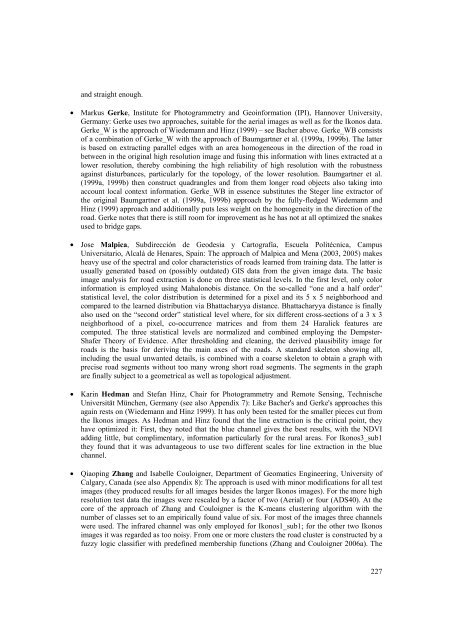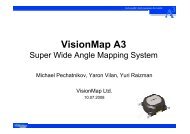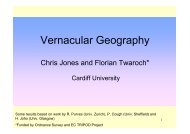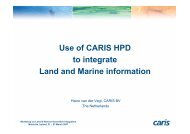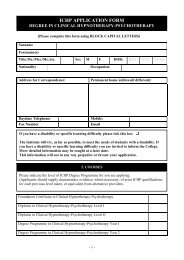EuroSDR Projects - Host Ireland
EuroSDR Projects - Host Ireland
EuroSDR Projects - Host Ireland
You also want an ePaper? Increase the reach of your titles
YUMPU automatically turns print PDFs into web optimized ePapers that Google loves.
and straight enough.<br />
• Markus Gerke, Institute for Photogrammetry and Geoinformation (IPI), Hannover University,<br />
Germany: Gerke uses two approaches, suitable for the aerial images as well as for the Ikonos data.<br />
Gerke_W is the approach of Wiedemann and Hinz (1999) – see Bacher above. Gerke_WB consists<br />
of a combination of Gerke_W with the approach of Baumgartner et al. (1999a, 1999b). The latter<br />
is based on extracting parallel edges with an area homogeneous in the direction of the road in<br />
between in the original high resolution image and fusing this information with lines extracted at a<br />
lower resolution, thereby combining the high reliability of high resolution with the robustness<br />
against disturbances, particularly for the topology, of the lower resolution. Baumgartner et al.<br />
(1999a, 1999b) then construct quadrangles and from them longer road objects also taking into<br />
account local context information. Gerke_WB in essence substitutes the Steger line extractor of<br />
the original Baumgartner et al. (1999a, 1999b) approach by the fully-fledged Wiedemann and<br />
Hinz (1999) approach and additionally puts less weight on the homogeneity in the direction of the<br />
road. Gerke notes that there is still room for improvement as he has not at all optimized the snakes<br />
used to bridge gaps.<br />
• Jose Malpica, Subdirección de Geodesia y Cartografía, Escuela Politécnica, Campus<br />
Universitario, Alcalá de Henares, Spain: The approach of Malpica and Mena (2003, 2005) makes<br />
heavy use of the spectral and color characteristics of roads learned from training data. The latter is<br />
usually generated based on (possibly outdated) GIS data from the given image data. The basic<br />
image analysis for road extraction is done on three statistical levels. In the first level, only color<br />
information is employed using Mahalonobis distance. On the so-called “one and a half order”<br />
statistical level, the color distribution is determined for a pixel and its 5 x 5 neighborhood and<br />
compared to the learned distribution via Bhattacharyya distance. Bhattacharyya distance is finally<br />
also used on the “second order” statistical level where, for six different cross-sections of a 3 x 3<br />
neighborhood of a pixel, co-occurrence matrices and from them 24 Haralick features are<br />
computed. The three statistical levels are normalized and combined employing the Dempster-<br />
Shafer Theory of Evidence. After thresholding and cleaning, the derived plausibility image for<br />
roads is the basis for deriving the main axes of the roads. A standard skeleton showing all,<br />
including the usual unwanted details, is combined with a coarse skeleton to obtain a graph with<br />
precise road segments without too many wrong short road segments. The segments in the graph<br />
are finally subject to a geometrical as well as topological adjustment.<br />
• Karin Hedman and Stefan Hinz, Chair for Photogrammetry and Remote Sensing, Technische<br />
Universität München, Germany (see also Appendix 7): Like Bacher's and Gerke's approaches this<br />
again rests on (Wiedemann and Hinz 1999). It has only been tested for the smaller pieces cut from<br />
the Ikonos images. As Hedman and Hinz found that the line extraction is the critical point, they<br />
have optimized it: First, they noted that the blue channel gives the best results, with the NDVI<br />
adding little, but complimentary, information particularly for the rural areas. For Ikonos3_sub1<br />
they found that it was advantageous to use two different scales for line extraction in the blue<br />
channel.<br />
• Qiaoping Zhang and Isabelle Couloigner, Department of Geomatics Engineering, University of<br />
Calgary, Canada (see also Appendix 8): The approach is used with minor modifications for all test<br />
images (they produced results for all images besides the larger Ikonos images). For the more high<br />
resolution test data the images were rescaled by a factor of two (Aerial) or four (ADS40). At the<br />
core of the approach of Zhang and Couloigner is the K-means clustering algorithm with the<br />
number of classes set to an empirically found value of six. For most of the images three channels<br />
were used. The infrared channel was only employed for Ikonos1_sub1; for the other two Ikonos<br />
images it was regarded as too noisy. From one or more clusters the road cluster is constructed by a<br />
fuzzy logic classifier with predefined membership functions (Zhang and Couloigner 2006a). The<br />
227


